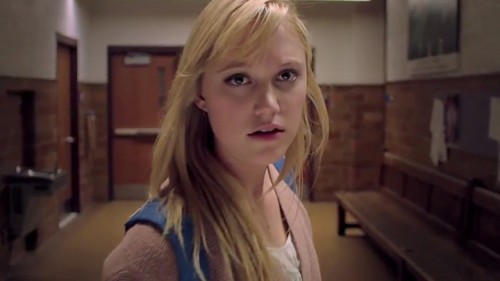Sex and Death, by Darrell Tuffs
David Robert Mitchell’s It Follows doesn’t particularly add anything new to the discussion of horror convention. Its central themes are as you might expect. The film deals with teen protagonists, with gruesome deaths, with sexual encounters, coming-of-age awakenings, and its supply of loud jump scare moments are plentiful. So, what then makes this film so unique, so challenging, and so very tense? The answer may be found within our nature as human beings, our expectations, our fantasies, and our primal fears.
The first thing to note is how much of a tactile film It Follows is, particularly where it concerns the human body and human flesh. The touching of skin and the sexualized voyeurism of gazes is greatly emphasized by Mitchell’s camera in the form of close-ups; close-ups of skin, of faces, of hair, hands stroking the surface of water, of the human desire to touch, to feel. Sitting behind the expected horror tropes of It Follows is something very evil, very voyeuristic and very obsessed. The obsession is found not only in following, or stalking, but in the way we gaze at other human beings, how we pick visual pieces of information apart, socially and sexually.
It Follows plays aggressively with the horror convention of sex, and its relationship to death. Sex and death, as portrayed in the film, feel deeply connected at the root. The fact that sex is such a vulnerable and trusting act, an act that should require a huge amount of neutral understanding, but also an act that can become extremely dangerous or negative when viewed or understood in uncompromised terms. It Follows taps chillingly into the vulnerability of sex, but also into an obsessive need to seek for it, regardless of any knowing dangers. We may begin to think of films such as Under the Skin, not from the alienated point of view of an outsider, but from the vulnerable viewpoint of its victims.
The film follows Jay, a young and admired female teenager, as she sits on the cusp of adulthood. A sexual encounter leaves Jay with, essentially, a curse, one that means she will be followed by an unknown entity, which can take the form of anyone, at any time, but one thing is for certain. Tt will not stop and will not give up until it reaches her. A slow, steady and ever looming presence, constantly following her, heading straight towards her at all times. But the premise becomes even more horrifying when we learn that once the follower reaches and gruesomely kills its victim, it then begins the process of working its way back down the line of previous holders of the curse, killing each one, until it reaches whomever started it.
The plot of It Follows not only creates an immediate sense of dread and paranoia for Jay, but for its audience too. The film’s characters are well set-up and established, meaning that we fear for them as we fear for ourselves. We can’t help but explore the camera’s frame, peering into the background of each shot, looking for any figures that may be walking towards us. Within It Follows, we begin to fear, and grow suspicious of other human beings, to become unsettled by their presence. We can’t help but see and spot unknown people walking within and past the frame’s edges, people who may, in reality, be completely harmless but we fear them because of the vulnerability and exposure of the anonymous.
This vulnerable and belittling feeling is created not only within the film’s horrifying plot, but too within its visual style. The tone of the film relies on its clever blending of huge, bellowing set pieces, with small and delicate moments of paranoia. Mixing moments that make us feel as though we are perfectly fine and safe with moments of skin-crawlingly immediate danger. It Follows often stands back at a distance, inviting us to explore and structurally pick apart its engulfing wide-shots and slow, circling camera pans. As an audience, we are often placed in awkward and obscured point-of-view shots, creating, at times, a somewhat claustrophobic tone but at others, an extremely agoraphobic tendency. The trick of the film is to create dread in the minds of the audience, even during its brief moments of serenity.
A major element in building this tone is the film’s score, created by Disasterpeace, who has also scored retro influenced indie video games such as Fez. The score of It Follows is like the film itself, holding a slightly sadistic dreamlike quality at times and thundering upon us a full-on nightmare at others. The music’s heavy synthesizer sounds, its low growling rumbles, and its high, desperate screams begin to follow us, reminding us when danger is lightly lingering and alerting us when danger is standing right behind us. At times, the music becomes so conflicted and intertwined within itself that it turns into plain noise, into a mess of twisted individual sounds, wrapping themselves around one another, creating pure uncanny uncertainty and evil.
Earlier, I mentioned that It Follows does not appear to add anything new to the classical conventions of the horror genre. This is true but that doesn’t mean to say that the film doesn’t challenge those conventions in any way. In fact, we might say that It Follows does nothing but challenge horror conventions, for its main premise is based upon the foundational stereotypes of many influential horror films. Within the film’s direct references to the “It”, the many connections between a fascination for attraction and sex, as well as its blunt attitude for establishing the fact that the world of the film is run by and around teenagers and teenage concerns, It Follows grabs our focus and forces us to actively think about the genre of horror itself. It Follows is smarter than parody; it does not just take the tools that have come before and use them for its own advantage. Rather, the film is a pastiche. It uses voyeurism, it uses youth, sex, vulnerability, indifference, and shock tactics in a way that allows us to question why these elements were even effective in the first place. It Follows is like experiencing a horrific nightmare but one that, at the same time, asks you to think about why the things you are seeing are scary and why the things you are feeling are effective.
It’s a big claim but due to its core effectiveness of tapping into our nature as human beings to want to keep safe, avoid danger, and suspect everything that may cause us harm, It Follows is perhaps one of the most effective horror films ever made. You might ask; what exactly is the “It” that follows? I would argue that, for us, it’s the film itself. It Follows is a fun and thrilling experience but be warned, it may stay with you, lurking in the background of your memories, until that day on an empty street when you glance over your shoulder to see that blurred figure in the distance, heading straight towards you.






























Great review, and great movie. An instant classic in the horror genre as far as I’m concerned. Scared the shiiiiit out of me.